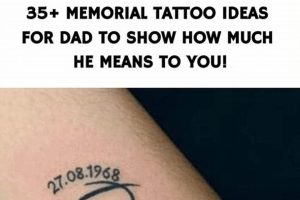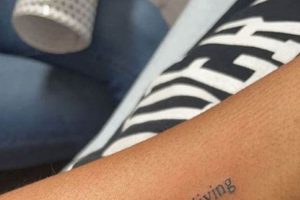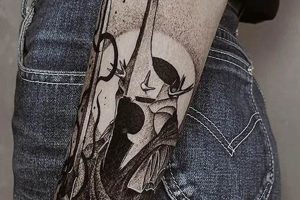Tattoos inspired by the American West encompass a wide range of imagery, drawing from the history, folklore, and culture of the frontier. Common motifs include cowboys, Native American symbolism, horses, wildlife such as eagles and snakes, weaponry like revolvers and knives, desert landscapes, and iconic symbols like the horseshoe and longhorn skull. These designs can be rendered in various styles, from classic American traditional to realistic portraiture and even neo-traditional approaches.
These designs often hold personal meaning for the wearer, representing values such as freedom, independence, resilience, and connection to nature or heritage. The enduring appeal of this genre lies in its powerful imagery and the rich history it evokes. From the romanticized cowboy figure to the spiritual significance of indigenous iconography, these tattoos offer a visual language for expressing a connection to a particular time and place in American history.
Exploring specific design elements within this broad category offers a deeper understanding of the genre’s versatility and the potential for creating unique and meaningful body art. Consideration of style, placement, and the artist’s expertise are crucial elements in the process of selecting the perfect design.
1. Imagery
The power of Western-themed tattoos lies significantly in their imagery. Selecting appropriate visuals is crucial for conveying the desired message and aesthetic. These designs draw from a rich visual vocabulary, offering a diverse range of options for self-expression.
- Characters
Depictions of cowboys, Native Americans, outlaws, and lawmen form a core element of Western imagery. These figures can represent specific historical individuals or archetypes embodying values like rugged individualism, resilience, and a life lived on one’s own terms. For example, a portrait of a stoic cowboy might symbolize strength and independence.
- Wildlife
Animals native to the American West, such as eagles, horses, snakes, wolves, and bison, feature prominently. These creatures carry symbolic weight, representing qualities like freedom, power, and connection to nature. An eagle tattoo, for instance, can symbolize freedom and spiritual connection.
- Objects and Symbols
Items associated with the West, including revolvers, horseshoes, cacti, feathers, dreamcatchers, and skulls, contribute to the overall narrative. These objects can represent specific aspects of Western culture or hold personal meaning for the wearer. A horseshoe, for example, is often seen as a symbol of good luck.
- Landscapes
Desert scenes, mountains, and open prairies evoke the vastness and untamed beauty of the American West. These background elements can create a powerful sense of place and atmosphere, enhancing the overall impact of the tattoo. A desert landscape, for instance, might symbolize resilience and the ability to thrive in harsh conditions.
Careful selection and combination of these imagery elements allow for the creation of deeply personal and evocative tattoos. The chosen imagery contributes significantly to the tattoo’s overall meaning and aesthetic, allowing individuals to express their connection to the history, mythology, and spirit of the American West.
2. Placement
Placement significantly impacts the visual impact and narrative of Western-inspired tattoos. Consideration of body contours, design size and complexity, and the potential for creating larger, interconnected pieces influences placement choices. Strategic placement enhances the storytelling potential of these designs.
- Arms and Legs
The arms and legs offer ample canvas for showcasing detailed designs, particularly elongated compositions featuring elements like snakes, whips, or floral motifs. These placements allow for designs to wrap around the limbs, creating a dynamic visual flow. Full or half sleeves can incorporate multiple Western elements, creating a cohesive narrative.
- Chest and Back
Larger designs, such as landscapes, portraits of iconic figures, or intricate scenes depicting Western life, often find their home on the chest or back. These broad, relatively flat surfaces provide ample space for detailed artwork. A large back piece might showcase a dramatic scene of a cowboy on horseback against a sunset backdrop.
- Hands and Feet
Smaller, symbolic designs, like horseshoes, stars, feathers, or brands, can be effectively placed on the hands or feet. These placements offer a more subtle approach, allowing for discreet displays of Western-inspired imagery. A small horseshoe on the hand can serve as a personal good luck charm.
- Ribs and Sides
The ribs and sides, though more sensitive areas, can be compelling locations for designs that follow the natural curves of the body. Designs incorporating elements like cacti, floral patterns, or weaponry can be strategically placed to accentuate these contours. A design of a Colt revolver along the ribs can create a striking visual effect.
Ultimately, the choice of placement depends on the specific design, desired visibility, and the wearer’s personal preferences. By carefully considering the interplay between placement and imagery, individuals can ensure their Western-inspired tattoos are both visually appealing and narratively resonant.
3. Style
Style significantly influences the overall aesthetic and impact of Western-themed tattoos. Different artistic styles imbue these designs with distinct characteristics, impacting their visual appeal and how they convey the narrative of the American West. Selecting the appropriate style is crucial for achieving the desired effect.
American Traditional emphasizes bold lines, vibrant colors, and simplified imagery. This style lends itself well to iconic Western motifs like eagles, roses, and skulls, creating a classic and timeless look. A traditional eagle tattoo, for example, would likely feature strong outlines, solid colors, and a limited color palette.
Realism focuses on detailed, lifelike depictions. Portraits of cowboys, Native Americans, or wildlife rendered in a realistic style can create powerful and evocative imagery. A realistic portrait of a horse, for example, might capture the intricate details of its musculature and coat.
Neo-Traditional blends elements of traditional and modern tattooing. This style often incorporates bolder color palettes, more intricate details, and illustrative qualities. A neo-traditional depiction of a snake might involve dynamic posing, vibrant colors, and decorative elements.
Blackwork utilizes solid black ink to create striking, high-contrast designs. This style can be particularly effective for depicting geometric patterns, silhouettes, or bold representations of Western imagery like longhorns or cacti.
Black and Grey relies on shading and varying tones of black and grey ink to create depth and realism. This style can be used to depict portraits, landscapes, or detailed scenes from the American West, offering a nuanced and atmospheric approach. A black and grey depiction of a desert landscape, for instance, might capture the subtle gradations of light and shadow.
Matching the chosen style to the desired imagery and overall theme is essential. A realistic portrait might not achieve the same impact in a traditional style, while a simple horseshoe might not suit the intricacies of a neo-traditional approach. Considering the strengths of each style and how they interact with Western imagery ensures a cohesive and effective final product. The style significantly contributes to the tattoo’s ability to tell a story, evoke a particular era, and resonate with the wearer’s personal connection to the American West.
4. Color Palette
Color palettes play a significant role in shaping the mood, aesthetic, and historical context of Western-inspired tattoos. Careful color selection can evoke specific emotions, time periods, and artistic styles, enhancing the narrative and visual impact of the design. Color choices contribute significantly to the overall effectiveness of these tattoos.
- Traditional Palettes
Traditional Western tattoo palettes often feature bold, primary colors such as red, yellow, and blue, along with black and white. These palettes create a classic, timeless look reminiscent of early American tattooing. A traditional cowboy tattoo might utilize these colors to depict a bandana, shirt, or other details, creating a vibrant and recognizable aesthetic.
- Realistic Color Schemes
Realistic Western tattoos often employ a broader range of colors to accurately depict skin tones, landscapes, and natural elements. These palettes prioritize capturing the true colors of the subject matter, enhancing the lifelike quality of the design. A realistic portrait of a Native American, for example, would require a nuanced color palette to capture the individual’s skin tone and facial features.
- Muted and Earth Tones
Muted colors and earth tones, such as browns, greens, and muted reds, can create a sense of age, history, and connection to the natural world. These palettes often evoke the dusty landscapes and aged textures of the American West. A tattoo depicting a desert landscape might utilize these colors to create a sense of realism and atmosphere.
- Black and Grey Realism
Black and grey palettes focus on creating depth, contrast, and realism through variations in shading and tone. These palettes can be particularly effective for depicting portraits, detailed scenes, and textures, lending a sense of drama and timelessness to the design. A black and grey portrait of an outlaw, for example, might emphasize the character’s rugged features and weathered appearance.
The selected color palette significantly influences the overall impact and interpretation of a Western tattoo. Choosing a palette that complements the imagery, style, and desired mood enhances the narrative and personal significance of the design. The skillful use of color can elevate a Western tattoo from a simple image to a powerful piece of art that resonates with the wearer and evokes the spirit of the American West.
5. Artist Selection
Artist selection holds paramount importance in realizing successful Western-themed tattoos. The chosen artist’s skill, experience, and stylistic specialization directly influence the final result. A deep understanding of Western imagery, historical context, and appropriate techniques is crucial for effectively translating these concepts into compelling body art. An artist’s portfolio should demonstrate proficiency in the desired style, whether traditional American, realism, or neo-traditional, and showcase prior experience with Western-themed pieces. Choosing an artist specializing in portraiture, for example, ensures a lifelike depiction of a historical figure like Wyatt Earp, whereas an artist skilled in black and grey realism might better capture the nuances of a desert landscape.
Researching and selecting a reputable artist significantly impacts the tattoo’s quality, longevity, and ability to capture the desired aesthetic. Recommendations, online portfolios, and consultations provide valuable insights into an artist’s capabilities and artistic approach. Visiting tattoo conventions offers opportunities to observe artists’ work firsthand and discuss project ideas. For instance, an artist specializing in Native American imagery might possess knowledge of specific tribal designs and their cultural significance, ensuring respectful and accurate representation. Conversely, selecting an artist without relevant experience could result in a poorly executed or culturally insensitive design.
Investing time in artist selection ensures the realization of a high-quality, meaningful Western tattoo that reflects the wearer’s vision and respects the rich history and symbolism of the genre. This careful consideration ultimately contributes to a piece of body art that resonates with the individual and stands the test of time. A well-executed Western tattoo becomes a powerful form of self-expression, reflecting not only the wearer’s personal narrative but also the artistry and expertise of the chosen tattooist.
Tips for Choosing Western Tattoo Ideas
Careful planning ensures a meaningful and well-executed Western tattoo. The following tips offer guidance for navigating the process of selecting a design that resonates with personal style and effectively conveys the desired narrative.
Tip 1: Research Thoroughly
Explore various Western themes, imagery, and styles before settling on a design. Examining historical photographs, artwork, and existing tattoos provides inspiration and helps refine design choices. Understanding the historical context of chosen imagery ensures a respectful and informed approach. For example, researching specific Native American tribal symbols ensures accurate representation and avoids cultural appropriation.
Tip 2: Consider Placement Carefully
Placement impacts both the visual presentation and the ability to incorporate future additions. Larger pieces benefit from spacious areas like the back or chest, while smaller designs suit the arms, legs, or hands. Consider how the design will interact with body contours and existing tattoos.
Tip 3: Choose a Reputable Artist
An experienced artist specializing in the desired style is crucial. Review portfolios and seek recommendations to find an artist whose work aligns with personal preferences. Discuss the design concept thoroughly during a consultation to ensure a clear understanding of the vision.
Tip 4: Reflect on Personal Meaning
A meaningful tattoo resonates with personal values and experiences. Connect the chosen imagery to individual stories or beliefs to imbue the tattoo with deeper significance. A tattoo of a horse, for example, could symbolize a personal connection to these animals or represent freedom and strength.
Tip 5: Plan for Long-Term Care
Tattoos require ongoing care to maintain their vibrancy and prevent premature fading. Discuss aftercare procedures with the chosen artist and commit to following these instructions diligently. Protecting the tattoo from sun exposure and using appropriate moisturizing products contributes to its longevity.
Tip 6: Start Small if Unsure
If uncertain about a large or complex design, consider starting with a smaller, simpler piece. This approach allows individuals to experience the process and develop confidence before committing to more extensive body art. A small, symbolic tattoo can serve as a starting point for building a larger, cohesive design later on.
Tip 7: Don’t Rush the Decision
A tattoo is a permanent commitment. Taking time to thoroughly research, plan, and consider all aspects of the design ensures a final result that provides lasting satisfaction. Rushing the decision might lead to regrets later on.
By following these tips, individuals can approach the process of selecting Western tattoo ideas with confidence and ensure a result that embodies personal style, resonates with meaning, and stands the test of time.
Ultimately, these considerations culminate in a tattoo that not only enhances personal appearance but also tells a story, reflecting an individual’s connection to the history, mythology, and enduring spirit of the American West.
Frequently Asked Questions about Western Tattoos
This section addresses common inquiries regarding Western-themed tattoos, offering clarity on practical aspects and design considerations.
Question 1: How much do Western tattoos typically cost?
Cost depends on factors like size, complexity, artist’s experience, and studio location. Small, simple designs might range from a few hundred dollars, while larger, more intricate pieces can cost several thousand. Obtaining quotes from multiple reputable artists is advisable.
Question 2: How painful are Western tattoos?
Pain levels vary depending on placement, individual pain tolerance, and tattoo size. Areas with thinner skin or closer proximity to bone tend to be more sensitive. Discussing pain management options with the chosen artist can alleviate discomfort.
Question 3: How long do Western tattoos take to heal?
Healing typically takes 2-4 weeks. Proper aftercare, including keeping the tattoo clean and moisturized, is crucial for optimal healing and preventing complications.
Question 4: Can Western tattoos be covered up or removed?
Cover-ups and removals are possible but present challenges. Cover-ups require larger, darker designs to effectively conceal existing ink. Laser removal requires multiple sessions and might not completely erase the tattoo. Consulting with a specialist is essential before pursuing either option.
Question 5: What are the most popular Western tattoo designs?
Popular designs include cowboys, horses, eagles, snakes, skulls, cacti, and Native American imagery. However, the best designs reflect personal meaning and individual preferences.
Question 6: How should one choose the right Western tattoo design?
Consider personal interests, values, and desired aesthetic. Research various Western themes and styles to find inspiration. Consulting with an experienced artist assists in refining the concept and selecting appropriate imagery and placement.
Thorough research and careful planning contribute significantly to a successful and personally meaningful Western tattoo. Consulting with reputable artists and understanding the long-term commitment involved ensures a positive experience and a piece of body art that holds lasting value.
Further exploration of specific Western tattoo motifs and styles can provide additional inspiration and guidance.
Western Tattoo Ideas
Exploration of Western tattoo ideas reveals a rich tapestry of imagery, styles, and symbolic meanings. From iconic figures like cowboys and Native Americans to evocative landscapes and powerful wildlife, these designs offer a diverse range of options for personal expression. Careful consideration of imagery, placement, style, and color palette ensures a cohesive and impactful final product. The selection of a skilled artist specializing in the desired style remains paramount for achieving a high-quality, lasting tattoo.
Western tattoo designs represent more than mere adornment; they embody narratives of history, mythology, and personal connection to a specific cultural landscape. The enduring appeal of these designs lies in their capacity to evoke the spirit of the American West, its rugged individualism, and its untamed beauty. Ultimately, a well-executed Western tattoo serves as a powerful statement of identity, reflecting the wearer’s appreciation for this unique artistic genre and its enduring legacy.







